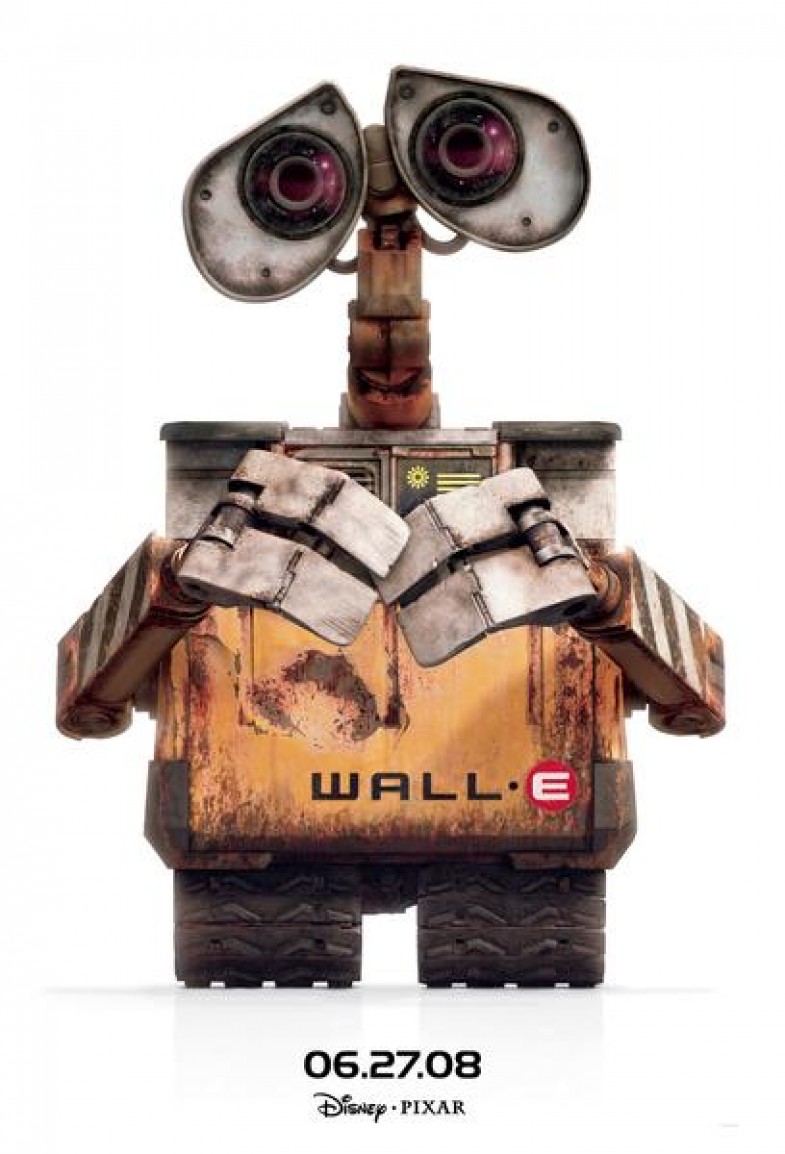WALL-E is surely one of the most subversive films to hit the big screen in years. What might easily be mistaken as a kids’ film because it is a feature-length cartoon is in fact a melancholy masterpiece that artfully combines a love story, dark satire and fierce social commentary about our nightmarish consumer culture.
The film, from Pixar/Disney (!), is the story of a sad, cute robot/trash compactor, the only apparent creature left on an abandoned Earth. WALL-E has been programmed by his creator, the Buy n Large Corporation, to clean up the monumental, crumbling mess of consumer crap strewn about by the human race. A century earlier, in the 21st Century, as Earth became uninhabitable, humanity decamped to a vast space colony that now aimlessly roams a distant galaxy. In the apocalyptic gloom that is now Earth, Wall-E dutifully stacks neat cubes of compacted trash into towering skyscrapers. (WALL-E stands for “Waste Allocation Load Lifter—Earth Class.)
Earthlings live in a manmade space environment that resembles a mall, tropical resort and freeway rolled into one. People spend their lives reclining in hovering Barcaloungers looking at translucent TV/computer screens propped up in front of them. They constantly sip Big Gulp sodas, gossip about celebrities, buy things and behave like sheep whenever the hear the voices of disembodied computers (think “HAL” in 2001) and the CEO of Buy n Large, the mega-corporation that used to govern Earth and now runs the floating space colony. (The CEO – the only live-action character in the film – is played to perfection by Fred Willard, who once specialized as the sleazy talk-show sidekick on “Fernwood 2Nite.”) Everyone is an obese, inert blob who can barely move.

I cannot recall a movie that so deftly lampoons and laments in one seamless narrative the sad, corrupt state of modern market culture. To be sure, the film’s message is delivered in the guise of a humorous cartoon – the preferred vehicle for messages that are otherwise too hot to handle. No film with WALL-E’s devastating themes could ever have gotten past the Hollywood gatekeepers unless it were disguised as some sort of kiddie fare – “good fun.” A frankly adult version of the film’s themes would be seen as far too depressing, political and controversial. And indeed, conservatives have predictably criticized the film.
What gives WALL-E its poignant charm – despite its heartbreakingly bleak premises – is the earnest resourcefulness and integrity of WALL-E and his almost-pathetic infatuation with Eve, a sleek, zippy, aerodynamic cylinder-robot also owned by the Buy n Large Corporation.
One day Eve arrives on Earth to investigate whether it has any viable lifeforms and therefore whether the “ghost ship” of humanity can return to Earth. It turns out that Wall-E had recently discovered a small green sprout of a plant, which Eve seizes. When Eve suddenly zooms off with the plant to notify the Buy n Large Corporation that Earth can now be re-colonized, WALL-E desperately tries to follow. (Eve stands for “Extraterrestrial Vegetation Evaluator.)
WALL-E is in love. She is the first “living” creature that he has seen in decades. The rest of the film revolves around WALL-E’s chase and courtship of Eve, and their adventures as “rogue robots” trying to save humanity from its narcoleptic existence.
The two robots are barely human, but, in this sci-fi universe, they are the most caring and humane creatures around. People have become slug-like blobs with no independent will, zest or love. By contrast, WALL-E takes immense childlike pleasure in the castoff emphemera of consumer culture that he finds while cleaning up the planet. He carefully stores and cherishes battered Rubrik’s cubes, elf dolls and cigarette lighters before trash-compacting everything else. He repeatedly watches a 1940s Hollywood musical film on an ancient videotape, which instills in him a longing to fall in love. WALL-E acts as a brave, sad counterpoint to the utter devastation of the Earth and the affectless humans who have become consumer-zombies.
This film doesn’t preach to make any points. It doesn’t need to. Kids immediately understand what’s going on, and adults do not feel as if it’s “just a kid’s movie.” It is a tribute to both the artistry of the film and its critique of consumer/corporate culture that WALL-E has grossed $267 million in the two months since its release. (There’s big money to be made in depicting alienation with modern consumerism!) My only complaint is that the film should probably have a PG, not a G, rating; I found it plenty disturbing.
The one thing the film does not tackle is how exactly humanity re-colonizes and revives the Earth. That’s when the film ends. Clearly that is a tale for another day. But one thing is clear: it will require another order of imagination entirely, something that goes beyond anything the Buy-N-Large Corporation has to offer, to save humans from their nightmarish exile in a Total Market Existence. They will need to find new ways to cooperate to save the small, green plant that WALL-E has improbably salvaged, and which is the uncredited centerpiece of the film: life.



